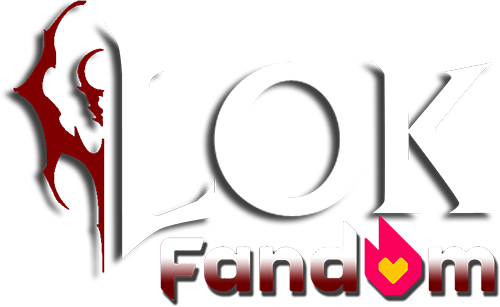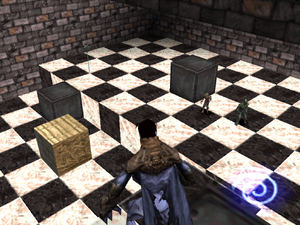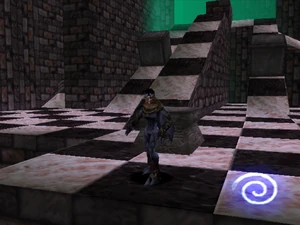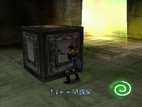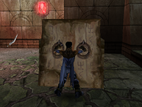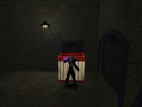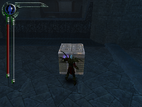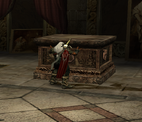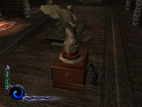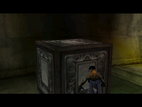The Device (talk | contribs) (→References: recat) |
Lord Aevum (talk | contribs) No edit summary |
||
| (26 intermediate revisions by 4 users not shown) | |||
| Line 1: | Line 1: | ||
[[File:SR2-Block-AirForge.png|thumb|300px|Raziel grabs hold of a block in ''Soul Reaver 2'']] |
[[File:SR2-Block-AirForge.png|thumb|300px|Raziel grabs hold of a block in ''Soul Reaver 2'']] |
||
| − | {{Qlisten|Your physical prowess surpasses what you knew in life. Even massive obstacles can be moved effortlessly.|The Elder God| |
+ | {{Qlisten|Your physical prowess surpasses what you knew in life. Even massive obstacles can be moved effortlessly.|The Elder God|VOICE20.XA-6-.oga|Legacy of Kain: Soul Reaver}} |
'''Blocks''', also known as '''Moveable Objects''', were a recurring element in the ''[[Legacy of Kain]]'' series, generally appearing as cube-shaped objects that can be moved by the protagonist. Often used as a component of puzzles, they can be either grabbed, dragged, pushed or on occasion even flipped into position, with varying effects. |
'''Blocks''', also known as '''Moveable Objects''', were a recurring element in the ''[[Legacy of Kain]]'' series, generally appearing as cube-shaped objects that can be moved by the protagonist. Often used as a component of puzzles, they can be either grabbed, dragged, pushed or on occasion even flipped into position, with varying effects. |
||
==Profile== |
==Profile== |
||
*'''Name:''' Blocks |
*'''Name:''' Blocks |
||
| − | *'''Category:''' [[:Category: |
+ | *'''Category:''' [[:Category:Terms|Recurring terms]] |
| − | *'''Introduced in:''' {{Icon |
+ | *'''Introduced in:''' {{Icon|Soul Reaver}} ''[[Legacy of Kain: Soul Reaver]]'' (1999) |
| − | *'''Appearances:''' {{Icon |
+ | *'''Appearances:''' {{Icon|Soul Reaver}} • {{Icon|Soul Reaver 2}} • {{Icon|Blood Omen 2}} • {{Icon|Defiance}} |
| − | *'''Related Articles:''' [[Chairs]], [[Boulders |
+ | *'''Related Articles:''' [[Chairs]], [[Boulders]], [[Constrict objects]], [[Rotatable and movable objects]], [[Glyph batteries]] |
| − | == |
+ | ==Profile== |
[[File:SR1-Screenshot-Term-Block2.png.png|thumb|Raziel's first encounter with a block in ''Soul Reaver'']] |
[[File:SR1-Screenshot-Term-Block2.png.png|thumb|Raziel's first encounter with a block in ''Soul Reaver'']] |
||
| − | Although basic moveable objects such as [[Chairs]] and [[ |
+ | Although basic moveable objects such as [[Chairs]] and [[Boulders]] had appeared in ''[[Blood Omen: Legacy of Kain]]'', ''[[Legacy of Kain: Soul Reaver]]'' was the first ''[[Legacy of Kain]]'' title to include true three- dimensional 'blocks' that could be grabbed and moved along with related puzzles.{{Ref|Blood Omen}}{{Ref|Soul Reaver}} Although their exact usage varied with title, block could generally be shoved and pushed, lifted and flipped or simply grabbed and moved backward, forward or sideways - usually this was necessary to put them in a specific place to further a jumping puzzle or just slot them into an appropriate place or orientation to activate a switch or complete a mural puzzle or similar system.{{Ref|Soul Reaver}}{{Ref|Soul Reaver 2}}{{Ref|Blood Omen 2}}{{Ref|Defiance}} |
| − | [[Raziel]] first encountered blocks on his exit from the [[Underworld ( |
+ | [[Raziel]] first encountered blocks on his exit from the [[Underworld (Soul Reaver)|Underworld]] in ''[[Legacy of Kain: Soul Reaver prologue]]'', shortly into the [[Sanctuary of the Clans]] area. Here the [[Elder God]] educated Raziel on their use and the basic mechanics associated with them and by moving the block to jump upward to a higher ledge (after defeating the nearby [[Fledgling Dumahim]]) Raziel was able to progress onward. Block puzzles were thereafter one of the most numerous forms of puzzle in ''[[Legacy of Kain: Soul Reaver]]'', appearing in virtually every chapter and major area including the outer areas of the Sanctuary of the Clans in ''[[Underworld (chapter)]]'', [[Raziel's Clan Territory]] in ''[[Raziel's Clan Territory (chapter)]]'', the [[Necropolis]] in ''[[Necropolis (chapter)]]'', the [[Silenced Cathedral]] in ''[[The Silenced Cathedral (chapter)]]'' (notable for having several block puzzles within), the [[Tomb of the Sarafan]] in ''[[Tomb Of Sarafan (chapter)]]'', [[File:SR1-Block-StoneGlyph-Mural-BlockPuzzle.png|thumb|The [[Stone Glyph Altar]] block puzzle]]the [[Ruined City]] in ''[[Ruined City of the Dumahim (chapter)]]'' and the [[Oracle's Cave]] in ''[[Oracle's Cave (chapter)]]''. Blocks and block puzzles were also used as puzzle elements in many optional areas like the [[Stone Glyph Altar]], [[Sunlight Glyph Altar]], [[City]] and the [[Water Glyph Altar]]. Blocks in ''Soul Reaver'' were uniquely able to be lifted and flipped over by [[Crouching]] alongside one of the faces enabling them to be turned over, which was useful in solving some of the more complicated puzzles which required the blocks to be correctly orientated in position.{{Ref|Soul Reaver}}{{Ref|Soul Reaver/1}}{{Ref|Soul Reaver/2}}{{Ref|Soul Reaver/3}}{{Ref|Soul Reaver/6}}{{Ref|Soul Reaver/7}}{{Ref|Soul Reaver/10}}{{Ref|Soul Reaver/13}} |
| − | Blocks returned in ''[[Soul Reaver 2]]'' in a much reduced capacity to their predecessors. With less optional puzzles and sidequests than ''[[Legacy of Kain: Soul Reaver]]'', and with many new and different elemental puzzle elements, blocks were confined to puzzle elements within the various elemental forges and were first encountered in the [[Dark Forge ( |
+ | Blocks returned in ''[[Soul Reaver 2]]'' in a much reduced capacity to their predecessors. With less optional puzzles and sidequests than ''[[Legacy of Kain: Soul Reaver]]'', and with many new and different elemental puzzle elements, blocks were confined to puzzle elements within the various elemental forges and were first encountered in the [[Dark Forge (Soul Reaver 2)|Dark forge]] in ''[[Through the Swamp]]''. Blocks in ''Soul Reaver 2'' could no longer be flipped and were often more thoroughly integrated into the environment - usually appearing as regular objects rather than the traditional cube-shaped block.{{Ref|Soul Reaver 2}}{{Ref|Soul Reaver 2/3}}{{Ref|Soul Reaver 2/4}}{{Ref|Soul Reaver 2/6}} |
<gallery type="slideshow" widths="250"> |
<gallery type="slideshow" widths="250"> |
||
SR1-Block-Drag-01.png |
SR1-Block-Drag-01.png |
||
| Line 30: | Line 30: | ||
SR1-Block-Flip-05.png |
SR1-Block-Flip-05.png |
||
</gallery> |
</gallery> |
||
| − | Blocks reappeared in ''[[Blood Omen 2]]'' with a slightly different feel to them. This time when in use, Kain would raise a single hand to move them - apparently utilizing a form of basic telekinesis to do so. Here they were again unable to be flipped and were no longer able to be sidestepped. [[Kain]] first encountered a moveable block in ''[[Welcome to Meridian|Chapter 1:]] [[Slums|The Slums]]'' towards the end of the level, when basic prompts were given about moving blocks. After this incident, the blocks of ''Blood Omen 2'' were seen fairly regularly as a basic puzzle element and generally retained a traditional cube shape though they were often justified as crates of some description. [[Glyph batteries]] - which were treated almost identically to regular blocks were also seen in the title.{{Ref| |
+ | Blocks reappeared in ''[[Blood Omen 2]]'' with a slightly different feel to them. This time when in use, Kain would raise a single hand to move them - apparently utilizing a form of basic telekinesis to do so. Here they were again unable to be flipped and were no longer able to be sidestepped. [[Kain]] first encountered a moveable block in ''[[Welcome to Meridian|Chapter 1:]] [[Slums|The Slums]]'' towards the end of the level, when basic prompts were given about moving blocks. After this incident, the blocks of ''Blood Omen 2'' were seen fairly regularly as a basic puzzle element and generally retained a traditional cube shape though they were often justified as crates of some description. [[Glyph batteries]] - which were treated almost identically to regular blocks were also seen in the title.{{Ref|Blood Omen 2}}{{Ref|Blood Omen 2/1}} |
| − | {{Ref| |
+ | {{Ref|Blood Omen 2/2}}{{Ref|Blood Omen 2/3}}{{Ref|Blood Omen 2/4}}{{Ref|Blood Omen 2/7}}{{Ref|Blood Omen 2/9}}{{Ref|Blood Omen 2/10}}{{Ref|Blood Omen 2/11}} |
| − | Blocks were again seen in ''[[Legacy of Kain: Defiance]]'' though due to the combat focus of the title, they were far less common than previously and were only seen on rare occasions. Blocks were first encountered by [[Kain]] in the relic room of the [[Sarafan Stronghold]] in ''[[Pursue Moebius]]'' and were thereafter seen occasionally as elements of basic puzzles. Much like in ''Soul Reaver 2'' blocks were able to be grabbed, dragged and sidestepped into place and were once again integrated into the environment as a common objects.{{Ref| |
+ | Blocks were again seen in ''[[Legacy of Kain: Defiance]]'' though due to the combat focus of the title, they were far less common than previously and were only seen on rare occasions. Blocks were first encountered by [[Kain]] in the relic room of the [[Sarafan Stronghold]] in ''[[Pursue Moebius]]'' and were thereafter seen occasionally as elements of basic puzzles. Much like in ''Soul Reaver 2'' blocks were able to be grabbed, dragged and sidestepped into place and were once again integrated into the environment as a common objects.{{Ref|Defiance}}{{Ref|Defiance/3}}{{Ref|Defiance/4}}{{Ref|Defiance/6}}{{Ref|Defiance/8}}{{Ref|Defiance/12}} |
| − | == |
+ | ==Development== |
<gallery type="slideshow"> |
<gallery type="slideshow"> |
||
SR1-Push1.png|The ''"Push 1"'' room left in SR1 game files |
SR1-Push1.png|The ''"Push 1"'' room left in SR1 game files |
||
| Line 41: | Line 41: | ||
SR1-Push6-3.PNG|Sloped Blocks in ''"Push6"'' |
SR1-Push6-3.PNG|Sloped Blocks in ''"Push6"'' |
||
</gallery> |
</gallery> |
||
| − | ''[[Legacy of Kain: Soul Reaver]]'' in particular featured numerous blocks and block-related puzzles, and with so many different variations the mechanics of block usage required extensive testing. Several [[Push and Test |
+ | ''[[Legacy of Kain: Soul Reaver]]'' in particular featured numerous blocks and block-related puzzles, and with so many different variations the mechanics of block usage required extensive testing. Several [[Push]] and [[Riley's Test Area|Test]] rooms exist in early versions of the game which were notably isolated from the main game world and were used by developers to test blocks, gameplay and other game elements, mechanics and features. At least 40 different push and test rooms were created for these purposes (labelled as ''"Test1"'' to ''"Test30"'' and ''"Push1"'' to ''"Push10"''), with many containing blocks - these rooms appear in [[Debug menus]] in early versions of the game and even into the retail version at least one room - ''"Push1"'' - survives in the files of ''Soul Reaver''. At least one block related mechanic was discarded from these testing processes with early versions and testing rooms containing several blocks on slopes that are not present in retail versions.{{Ref|Soul Reaver}}<ref name="TLW-SR1-PushTest">{{Icon|TLW}}[http://www.thelostworlds.net/SR1/The_Push_and_Test_Rooms.html The Push and Test Rooms] at [[The Lost Worlds]] (by Ben Lincoln)</ref> |
Among the fan community, ''[[Legacy of Kain: Soul Reaver]]'' is somewhat infamously associated with its numerous block-related puzzles and the title has often been criticized for its over-reliance on them. These complaints have been acknowledged several times in developer interviews and explained as the product of technical limitations and independent teams working on several areas simultaneously.<ref name="IGN-SR2-DirectorInterview">{{Icon-IGN}} [http://uk.ign.com/articles/2000/05/11/soul-reaver-2-directors-interview?page=2 Soul Reaver 2: Director's Interview (page 2)] at [http://www.ign.com/ IGN] (by Douglass C. Perry/Amy Hennig)</ref> According to director [[Amy Hennig]]: |
Among the fan community, ''[[Legacy of Kain: Soul Reaver]]'' is somewhat infamously associated with its numerous block-related puzzles and the title has often been criticized for its over-reliance on them. These complaints have been acknowledged several times in developer interviews and explained as the product of technical limitations and independent teams working on several areas simultaneously.<ref name="IGN-SR2-DirectorInterview">{{Icon-IGN}} [http://uk.ign.com/articles/2000/05/11/soul-reaver-2-directors-interview?page=2 Soul Reaver 2: Director's Interview (page 2)] at [http://www.ign.com/ IGN] (by Douglass C. Perry/Amy Hennig)</ref> According to director [[Amy Hennig]]: |
||
{{Quotebox-Opaque|''"Yeah, there were just too many of them. There are still blocks, and there's still dragging stuff, I think that's sort of a key behavior that you need in the game, but we just used them as a fallback way too many times. There are a few reasons for that: Part of it was different people working on different levels and suddenly you look at how it comes together and oh, wow, we all used blocks. But the other part was just trying to come up with more in-depth puzzles and not having enough tools in the toolbox. So that's something we addressed right away, well how can we get more tools in the toolbox? The engine already had a lot of capabilities -- the whole goal all along with the engine was to make sure that the designers and artists really had the autonomous power to do cool stuff on their own and not have to put a request in to the programmers. You can key up cinematics, which you can key up puzzle events, all based on this contextual scripting system. We're doing a lot more of that."''|'''Amy Hennig'''<ref name="IGN-SR2-DirectorInterview"/>}} |
{{Quotebox-Opaque|''"Yeah, there were just too many of them. There are still blocks, and there's still dragging stuff, I think that's sort of a key behavior that you need in the game, but we just used them as a fallback way too many times. There are a few reasons for that: Part of it was different people working on different levels and suddenly you look at how it comes together and oh, wow, we all used blocks. But the other part was just trying to come up with more in-depth puzzles and not having enough tools in the toolbox. So that's something we addressed right away, well how can we get more tools in the toolbox? The engine already had a lot of capabilities -- the whole goal all along with the engine was to make sure that the designers and artists really had the autonomous power to do cool stuff on their own and not have to put a request in to the programmers. You can key up cinematics, which you can key up puzzle events, all based on this contextual scripting system. We're doing a lot more of that."''|'''Amy Hennig'''<ref name="IGN-SR2-DirectorInterview"/>}} |
||
| − | Subsequent titles noticeably continued to use blocks as an element but did not retain the complex puzzles previously associated with them, instead concentrating on new and different puzzle elements. The blocks that are present in later titles were usually involved in simpler interactions, were unable to be flipped and were integrated into the environment much more seamlessly as ''"moveable objects"'' - nevertheless blocks and their interactions continued to be a part of the series in subsequent titles and were an element that even persisted into [[Crystal Dynamics]] subsequent projects.{{Ref| |
+ | Subsequent titles noticeably continued to use blocks as an element but did not retain the complex puzzles previously associated with them, instead concentrating on new and different puzzle elements. The blocks that are present in later titles were usually involved in simpler interactions, were unable to be flipped and were integrated into the environment much more seamlessly as ''"moveable objects"'' - nevertheless blocks and their interactions continued to be a part of the series in subsequent titles and were an element that even persisted into [[Crystal Dynamics]] subsequent projects.{{Ref|Soul Reaver}}{{Ref|Soul Reaver 2}}{{Ref|Blood Omen 2}}{{Ref|Defiance}} |
==Notes== |
==Notes== |
||
[[File:Defiance-Block-Fire.png|thumb|Raziel pulling a ring-bearing block in ''Defiance'']] |
[[File:Defiance-Block-Fire.png|thumb|Raziel pulling a ring-bearing block in ''Defiance'']] |
||
| − | *Where they appear, block are always classified under ''"objects"'' or more specifically ''"using objects"'' or ''"manipulating objects"''. Blocks are known by various other terms throughout the series - they are only indicated as the subject of conversation in cutscenes at the beginning of ''Legacy of Kain: Soul Reaver'' and are never directly addressed or named in dialogue.{{Ref| |
+ | *Where they appear, block are always classified under ''"objects"'' or more specifically ''"using objects"'' or ''"manipulating objects"''. Blocks are known by various other terms throughout the series - they are only indicated as the subject of conversation in cutscenes at the beginning of ''Legacy of Kain: Soul Reaver'' and are never directly addressed or named in dialogue.{{Ref|Soul Reaver/1}} The term ''"blocks"'' is used in a variety of sources however, including developer comments,<ref name="IGN-SR2-DirectorInterview" /> manuals{{Ref|Soul Reaver manual (US)}}{{Ref|Soul Reaver manual (UK)}}{{Ref|Blood Omen 2 manual (US)}}{{Ref|Blood Omen 2 manual (UK)}} and official guides{{Ref|Soul Reaver strategy guide (Prima)}}{{Ref|Soul Reaver 2 strategy guide (Prima)}}{{Ref|Blood Omen 2 strategy guide}}{{Ref|Defiance strategy guide}}, though this term seems to particularly refer to the obviously cuboid moveable blocks. Other terms used to describe them include ''"moveable blocks"''{{Ref|Blood Omen 2 manual (US)}}{{Ref|Blood Omen 2 manual (UK)}}, the more general ''"moveable objects"''{{Ref|Soul Reaver 2 manual}}{{Ref|Soul Reaver 2 strategy guide (Prima)}}{{Ref|Defiance manual}}, ''"crates"''{{Ref|Blood Omen 2 strategy guide}} or more descriptive terms based on the appearance of the object itself.{{Ref|Soul Reaver 2 strategy guide (Prima)}}{{Ref|Blood Omen 2 strategy guide}}{{Ref|Defiance strategy guide}}. The changes of terms through the series seem to be efforts to move away from traditional cube-shaped blocks and identify with a range of objects that can be moved in the same fashion. |
| − | *A number of similarly functioning 'moveable objects' have been seen throughout the series. Initially, [[Kain]] could move both [[Chairs]] and [[ |
+ | *A number of similarly functioning 'moveable objects' have been seen throughout the series. Initially, [[Kain]] could move both [[Chairs]] and [[Boulders]] in ''[[Blood Omen: Legacy of Kain]]'' though these were two-dimensional sprites which were unable to be grabbed or pulled and were usually used by manoeuvring them into position over [[Floor buttons]] or simply pushing them out of the way.{{Ref|Blood Omen}} ''[[Legacy of Kain: Soul Reaver]]'' also featured [[Constrict objects]] - blocks or other objects that could be rotated by [[Constricting]] them - which were usually stuck in place.{{Ref|Soul Reaver}}{{Ref|Soul Reaver/10}} ''[[Soul Reaver 2]]'' did away with the Constricting mechanic and instead allowed [[Raziel]] to rotate certain [[Rotatable and movable objects]] simply by turning them on the spot, with these again often stuck in position;{{Ref|Soul Reaver 2}} with ''[[Legacy of Kain: Defiance]]'' also using a similar set-up.{{Ref|Defiance}} Finally ''[[Blood Omen 2]]'' featured a similar set of objects known as [[Glyph batteries]], which behaved exactly the same as regular blocks in the game, only they could be used to bridge broken connections in the [[Glyph magic]] network or alternatively treated as explosives.{{Ref|Blood Omen 2}} |
| − | *After the numerous obvious block puzzles in ''[[Legacy of Kain: Soul Reaver]]'', Blocks in later titles were more thoroughly integrated into the environment and were often disguised as general objects, to the extent that the Blocks in ''[[Soul Reaver 2]]'' and ''[[Legacy of Kain: Defiance]]'' noticeably have one or more rings on them indicating an object that can be grabbed. Presumably, this was added to aid identification of blocks which were now less obvious in their environment.{{Ref| |
+ | *After the numerous obvious block puzzles in ''[[Legacy of Kain: Soul Reaver]]'', Blocks in later titles were more thoroughly integrated into the environment and were often disguised as general objects, to the extent that the Blocks in ''[[Soul Reaver 2]]'' and ''[[Legacy of Kain: Defiance]]'' noticeably have one or more rings on them indicating an object that can be grabbed. Presumably, this was added to aid identification of blocks which were now less obvious in their environment.{{Ref|Soul Reaver 2}}{{Ref|Defiance}} ''[[Blood Omen 2]]'' on the other hand featured minimal block integration and the blocks were usually instead more justified in the environment (such as crates in a warehouse), though there were occasions when blocks were hidden as general objects.{{Ref|Blood Omen 2}}{{Ref|Blood Omen 2/2}}{{Ref|Blood Omen 2/9}} |
==Gallery== |
==Gallery== |
||
| − | <gallery> |
+ | <gallery widths=142> |
SR1-Block-Train.png |
SR1-Block-Train.png |
||
SR1-Block-Pipe.png |
SR1-Block-Pipe.png |
||
| Line 72: | Line 72: | ||
SR1-Screenshot-Term-Block2.png.png |
SR1-Screenshot-Term-Block2.png.png |
||
</gallery> |
</gallery> |
||
| − | |||
| − | ==Appearances== |
||
| − | *{{Icon-SR1}} ''[[Legacy of Kain: Soul Reaver]]'' |
||
| − | *{{Icon-SR2}} ''[[Soul Reaver 2]]'' |
||
| − | *{{Icon-BO2}} ''[[Blood Omen 2]]'' |
||
| − | *{{Icon-Defiance}} ''[[Legacy of Kain: Defiance]]'' |
||
==See also== |
==See also== |
||
*[[Chairs]] |
*[[Chairs]] |
||
| − | *[[Boulders |
+ | *[[Boulders]] |
*[[Constrict objects]] |
*[[Constrict objects]] |
||
*[[Rotatable and movable objects]] |
*[[Rotatable and movable objects]] |
||
| Line 89: | Line 83: | ||
{{Reflist}} |
{{Reflist}} |
||
| + | ==Browse== |
||
| − | {{Navbox/ |
+ | {{Navbox/Terms}} |
| − | |||
| − | [[Category: |
+ | [[Category:Terms]] |
| − | [[Category: |
+ | [[Category:Terms/Blood Omen 2]] |
| − | [[Category: |
+ | [[Category:Terms/Defiance]] |
| − | [[Category: |
+ | [[Category:Terms/Soul Reaver]] |
| − | [[Category: |
+ | [[Category:Terms/Soul Reaver 2]] |
| − | [[Category: |
+ | [[Category:Browse]] |
| − | [[Category: |
+ | [[Category:Blood Omen 2]] |
| − | [[Category: |
+ | [[Category:Defiance]] |
| − | [[Category: |
+ | [[Category:Soul Reaver]] |
| − | [[Category: |
+ | [[Category:Soul Reaver 2]] |
Revision as of 02:54, 21 November 2019
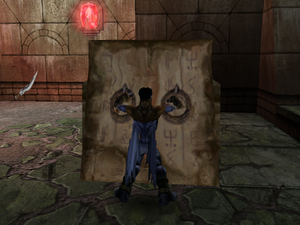
Raziel grabs hold of a block in Soul Reaver 2
Template:Qlisten Blocks, also known as Moveable Objects, were a recurring element in the Legacy of Kain series, generally appearing as cube-shaped objects that can be moved by the protagonist. Often used as a component of puzzles, they can be either grabbed, dragged, pushed or on occasion even flipped into position, with varying effects.
Profile
- Name: Blocks
- Category: Recurring terms
- Introduced in: File:Wiki-Icon-SR1.png Legacy of Kain: Soul Reaver (1999)
- Appearances: File:Wiki-Icon-SR1.png • File:Wiki-Icon-SR2.png • File:Wiki-Icon-BO2.png • File:Wiki-Icon-DEF.png
- Related Articles: Chairs, Boulders, Constrict objects, Rotatable and movable objects, Glyph batteries
Profile
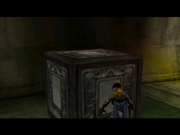
Raziel's first encounter with a block in Soul Reaver
Although basic moveable objects such as Chairs and Boulders had appeared in Blood Omen: Legacy of Kain, Legacy of Kain: Soul Reaver was the first Legacy of Kain title to include true three- dimensional 'blocks' that could be grabbed and moved along with related puzzles.[Blood Omen][Soul Reaver] Although their exact usage varied with title, block could generally be shoved and pushed, lifted and flipped or simply grabbed and moved backward, forward or sideways - usually this was necessary to put them in a specific place to further a jumping puzzle or just slot them into an appropriate place or orientation to activate a switch or complete a mural puzzle or similar system.[Soul Reaver][Soul Reaver 2][Blood Omen 2][Defiance]
Raziel first encountered blocks on his exit from the Underworld in Legacy of Kain: Soul Reaver prologue, shortly into the Sanctuary of the Clans area. Here the Elder God educated Raziel on their use and the basic mechanics associated with them and by moving the block to jump upward to a higher ledge (after defeating the nearby Fledgling Dumahim) Raziel was able to progress onward. Block puzzles were thereafter one of the most numerous forms of puzzle in Legacy of Kain: Soul Reaver, appearing in virtually every chapter and major area including the outer areas of the Sanctuary of the Clans in Underworld (chapter), Raziel's Clan Territory in Raziel's Clan Territory (chapter), the Necropolis in Necropolis (chapter), the Silenced Cathedral in The Silenced Cathedral (chapter) (notable for having several block puzzles within), the Tomb of the Sarafan in Tomb Of Sarafan (chapter),
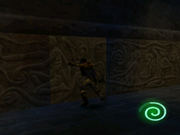
The Stone Glyph Altar block puzzle
the Ruined City in Ruined City of the Dumahim (chapter) and the Oracle's Cave in Oracle's Cave (chapter). Blocks and block puzzles were also used as puzzle elements in many optional areas like the Stone Glyph Altar, Sunlight Glyph Altar, City and the Water Glyph Altar. Blocks in Soul Reaver were uniquely able to be lifted and flipped over by Crouching alongside one of the faces enabling them to be turned over, which was useful in solving some of the more complicated puzzles which required the blocks to be correctly orientated in position.[Soul Reaver][Soul Reaver/1][Soul Reaver/2][Soul Reaver/3][Soul Reaver/6][Soul Reaver/7][Soul Reaver/10][Soul Reaver/13]
Blocks returned in Soul Reaver 2 in a much reduced capacity to their predecessors. With less optional puzzles and sidequests than Legacy of Kain: Soul Reaver, and with many new and different elemental puzzle elements, blocks were confined to puzzle elements within the various elemental forges and were first encountered in the Dark forge in Through the Swamp. Blocks in Soul Reaver 2 could no longer be flipped and were often more thoroughly integrated into the environment - usually appearing as regular objects rather than the traditional cube-shaped block.[Soul Reaver 2][Soul Reaver 2/3][Soul Reaver 2/4][Soul Reaver 2/6]
Blocks reappeared in Blood Omen 2 with a slightly different feel to them. This time when in use, Kain would raise a single hand to move them - apparently utilizing a form of basic telekinesis to do so. Here they were again unable to be flipped and were no longer able to be sidestepped. Kain first encountered a moveable block in Chapter 1: The Slums towards the end of the level, when basic prompts were given about moving blocks. After this incident, the blocks of Blood Omen 2 were seen fairly regularly as a basic puzzle element and generally retained a traditional cube shape though they were often justified as crates of some description. Glyph batteries - which were treated almost identically to regular blocks were also seen in the title.[Blood Omen 2][Blood Omen 2/1] [Blood Omen 2/2][Blood Omen 2/3][Blood Omen 2/4][Blood Omen 2/7][Blood Omen 2/9][Blood Omen 2/10][Blood Omen 2/11]
Blocks were again seen in Legacy of Kain: Defiance though due to the combat focus of the title, they were far less common than previously and were only seen on rare occasions. Blocks were first encountered by Kain in the relic room of the Sarafan Stronghold in Pursue Moebius and were thereafter seen occasionally as elements of basic puzzles. Much like in Soul Reaver 2 blocks were able to be grabbed, dragged and sidestepped into place and were once again integrated into the environment as a common objects.[Defiance][Defiance/3][Defiance/4][Defiance/6][Defiance/8][Defiance/12]
Development
Legacy of Kain: Soul Reaver in particular featured numerous blocks and block-related puzzles, and with so many different variations the mechanics of block usage required extensive testing. Several Push and Test rooms exist in early versions of the game which were notably isolated from the main game world and were used by developers to test blocks, gameplay and other game elements, mechanics and features. At least 40 different push and test rooms were created for these purposes (labelled as "Test1" to "Test30" and "Push1" to "Push10"), with many containing blocks - these rooms appear in Debug menus in early versions of the game and even into the retail version at least one room - "Push1" - survives in the files of Soul Reaver. At least one block related mechanic was discarded from these testing processes with early versions and testing rooms containing several blocks on slopes that are not present in retail versions.[Soul Reaver][1]
Among the fan community, Legacy of Kain: Soul Reaver is somewhat infamously associated with its numerous block-related puzzles and the title has often been criticized for its over-reliance on them. These complaints have been acknowledged several times in developer interviews and explained as the product of technical limitations and independent teams working on several areas simultaneously.[2] According to director Amy Hennig: Template:Quotebox-Opaque
Subsequent titles noticeably continued to use blocks as an element but did not retain the complex puzzles previously associated with them, instead concentrating on new and different puzzle elements. The blocks that are present in later titles were usually involved in simpler interactions, were unable to be flipped and were integrated into the environment much more seamlessly as "moveable objects" - nevertheless blocks and their interactions continued to be a part of the series in subsequent titles and were an element that even persisted into Crystal Dynamics subsequent projects.[Soul Reaver][Soul Reaver 2][Blood Omen 2][Defiance]
Notes
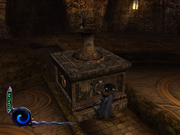
Raziel pulling a ring-bearing block in Defiance
- Where they appear, block are always classified under "objects" or more specifically "using objects" or "manipulating objects". Blocks are known by various other terms throughout the series - they are only indicated as the subject of conversation in cutscenes at the beginning of Legacy of Kain: Soul Reaver and are never directly addressed or named in dialogue.[Soul Reaver/1] The term "blocks" is used in a variety of sources however, including developer comments,[2] manuals[Soul Reaver manual (US)][Soul Reaver manual (UK)][Blood Omen 2 manual (US)][Blood Omen 2 manual (UK)] and official guides[Soul Reaver strategy guide (Prima)][Soul Reaver 2 strategy guide (Prima)][Blood Omen 2 strategy guide][Defiance strategy guide], though this term seems to particularly refer to the obviously cuboid moveable blocks. Other terms used to describe them include "moveable blocks"[Blood Omen 2 manual (US)][Blood Omen 2 manual (UK)], the more general "moveable objects"[Soul Reaver 2 manual][Soul Reaver 2 strategy guide (Prima)][Defiance manual], "crates"[Blood Omen 2 strategy guide] or more descriptive terms based on the appearance of the object itself.[Soul Reaver 2 strategy guide (Prima)][Blood Omen 2 strategy guide][Defiance strategy guide]. The changes of terms through the series seem to be efforts to move away from traditional cube-shaped blocks and identify with a range of objects that can be moved in the same fashion.
- A number of similarly functioning 'moveable objects' have been seen throughout the series. Initially, Kain could move both Chairs and Boulders in Blood Omen: Legacy of Kain though these were two-dimensional sprites which were unable to be grabbed or pulled and were usually used by manoeuvring them into position over Floor buttons or simply pushing them out of the way.[Blood Omen] Legacy of Kain: Soul Reaver also featured Constrict objects - blocks or other objects that could be rotated by Constricting them - which were usually stuck in place.[Soul Reaver][Soul Reaver/10] Soul Reaver 2 did away with the Constricting mechanic and instead allowed Raziel to rotate certain Rotatable and movable objects simply by turning them on the spot, with these again often stuck in position;[Soul Reaver 2] with Legacy of Kain: Defiance also using a similar set-up.[Defiance] Finally Blood Omen 2 featured a similar set of objects known as Glyph batteries, which behaved exactly the same as regular blocks in the game, only they could be used to bridge broken connections in the Glyph magic network or alternatively treated as explosives.[Blood Omen 2]
- After the numerous obvious block puzzles in Legacy of Kain: Soul Reaver, Blocks in later titles were more thoroughly integrated into the environment and were often disguised as general objects, to the extent that the Blocks in Soul Reaver 2 and Legacy of Kain: Defiance noticeably have one or more rings on them indicating an object that can be grabbed. Presumably, this was added to aid identification of blocks which were now less obvious in their environment.[Soul Reaver 2][Defiance] Blood Omen 2 on the other hand featured minimal block integration and the blocks were usually instead more justified in the environment (such as crates in a warehouse), though there were occasions when blocks were hidden as general objects.[Blood Omen 2][Blood Omen 2/2][Blood Omen 2/9]
Gallery
See also
References
- ↑ File:Wiki-Icon-TLW.pngThe Push and Test Rooms at The Lost Worlds (by Ben Lincoln)
- ↑ 2.0 2.1 Template:Icon-IGN Soul Reaver 2: Director's Interview (page 2) at IGN (by Douglass C. Perry/Amy Hennig)
